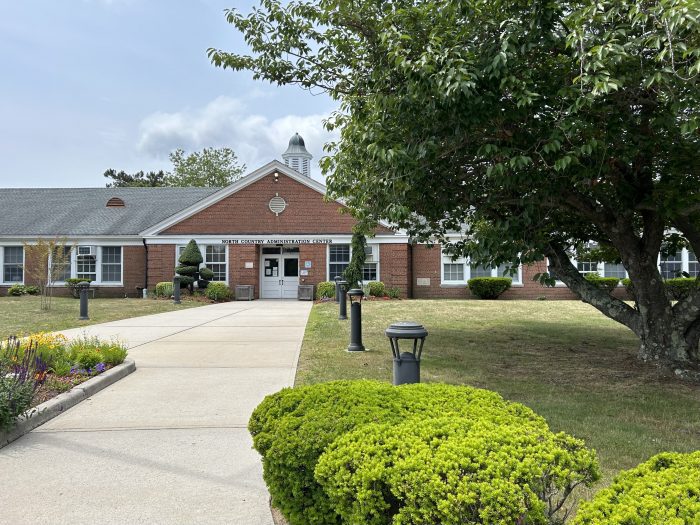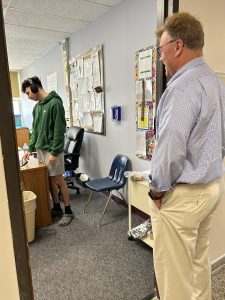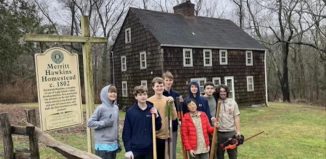Three Village Academy offers an alternative road to success
Academy students may have fallen through the cracks on larger campuses

Tucked behind a quiet Stony Brook neighborhood sits the least known school in Three Village Central School District: Three Village Academy, home base for about 55 ninth through 12th graders each year who have had a tough time socially or emotionally, and who may otherwise have fallen through the cracks at larger secondary schools in the district.

At a time children and teens nationwide are struggling with increased anxiety, depression and other mental health issues, the academy, which shares a building with district administration offices, offers a distinctly lower-key environment than the massive, stately Ward Melville High School, population 1,520.
It is a general education program — not special education, though about half of the students have accommodation plans, and not a behavioral intervention program. The academy is primarily for in-district students, but a small portion are sent and paid for by other districts: Smithtown, Commack, Port Jefferson and Sachem, among others, and there are typically about 15 out-of-district students on a waiting list, according to academy principal Gus Hueber.
The academy provides a way for all of its students to receive the same quality of education as any other Three Village student, but with more one-to-one attention and support, and less social pressure.
“Some kids, at whatever moment in their life they are struggling, there’s a window we work with them, we support them,” said Hueber, who has served as principal since the academy’s inception 10 years ago. “It’s not magic; it really is just providing them with a safe and trusting place and trusting relationships,” he added.
But for some families, it may feel like magic when a child with chronic absenteeism suddenly has a safe place they willingly attend.
Like Tabitha DeMuria’s daughter Jenny [not her real name], who was in ninth grade at P.J. Gelinas Junior High School during the 2020-2021 school year when she started missing school. Since it was the middle of the COVID-19 pandemic, Jenny could simply do course work online. Before long, even that stopped, DeMuria said. “She just shut down.”
COVID-19 stress was an exacerbating factor, but struggle had already been brewing. Jenny was coming to terms with the aftermath of a tragedy in her family, and she faced bullying by some girls at school.
When Jenny toured the academy, teachers she met were warm and friendly, as were her peers. “The students came up to her — not knowing who she was — and told her, ‘You’re going to do great here,’” DeMuria said.
Because the school is in-district, the transition was swift and smooth. Academy teachers split their time with the other Three Village secondary schools, and the curriculum is the same. By the time school broke for summer in 2021, Jenny had vastly improved all the grades that had dropped due to repeated absences, according to DeMuria.
Support staff like guidance counselors and school psychologists play an important role, but the teachers themselves become a huge part of these students’ lives. They eat lunch in the same room as the students, they join together for kickball or volleyball and they attend the academy’s prom.
Superintendent of Schools Kevin Scanlon, who helped launch the academy when he was assistant superintendent, set the tone for the school’s culture by hand picking teachers. Scanlon said he told incoming staff that flexibility is vital. “If you are rigid as a teacher and rigid as a person, this is not the right program for you,” he told them.
The closeness of the relationship among staff and students brings a sense of ownership and pride to the community. Academy students get together at the beginning of the school year to create rules for public spaces, like the hallway, and they post signs detailing those expectations. “Don’t be on your phones — keep your eyes up,” one sign reads. “We will not scream, push or make inappropriate sounds,” reads another.
They create murals in school hallways; a version of Vincent Van Gogh’s “Starry Night,” for one. DeMuria said mural painting helps ease Jenny’s anxiety. “All of her stress is gone when she’s able to do something like that,” she said.
Some academy students ride a bus to the high school for the afternoon if they’d like to take AP classes or participate in sports, and others go to BOCES vocational programs to earn certificates in things like cosmetology or auto mechanics. Many of the graduates, according to Scanlon, would most likely not have graduated if they’d stayed at Ward Melville. Others, including Jenny, choose to return to the big school after a few years and wind up graduating there.
Stories of success and growth like Jenny’s are common at Three Village Academy. According to Hueber, every year at graduation when seniors share how far they’ve come from dark places thanks to academy staff, there’s not a dry eye in the room.
“You have no idea the impact you’ve made on certain kids,” he said.






